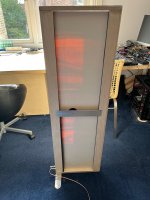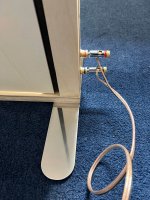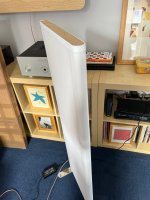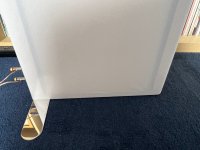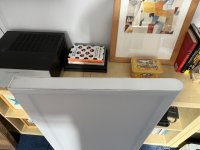Thanks SteveEucy.
I believe that in the early days the NXT team did spend rather a lot of money on building a tensioned mylar panel speaker, with limited success.
Steve.
Good to know... Wonder where it failed?
Someone else on the same track some time ago
https://www.diyaudio.com/community/threads/nxt-exciter-on-mylar-diaphragm.178543/
Eucy
Last edited:
Snow White
Hi all, I hope you are all well. It looks like you have all been very busy extending the state of the art.
I thought I’d share a few shots of my latest effort which is for the TV downstairs. I am exploiting the omni nature of DML’s and placing them ‘edge’ on to the viewing area which reduces the visual impact a lot which the wife likes. The design is the standard high aspect ration 3mm Spruce ply set in a Birch ply frame so nothing unusual. The only deviation from the norm is I have radiused the front edge to promote a smooth diffraction for high frequencies from the panel. I have no idea if this works but it was making me kind of itchy not doing it.
They sound good, just as you would expect from DML, but I really need to update my TV 🙂
Burnt
Hi all, I hope you are all well. It looks like you have all been very busy extending the state of the art.
I thought I’d share a few shots of my latest effort which is for the TV downstairs. I am exploiting the omni nature of DML’s and placing them ‘edge’ on to the viewing area which reduces the visual impact a lot which the wife likes. The design is the standard high aspect ration 3mm Spruce ply set in a Birch ply frame so nothing unusual. The only deviation from the norm is I have radiused the front edge to promote a smooth diffraction for high frequencies from the panel. I have no idea if this works but it was making me kind of itchy not doing it.
They sound good, just as you would expect from DML, but I really need to update my TV 🙂
Burnt
Attachments
Last edited:
Very cool! How is the board mounted to the frame? The black stuff on the sides is some sort of foam glued to the main panel?
Thank you pelanj, kind of you to say. Yes the Spruce panels are mounted on soft double sided foam tape as usual. Its 20mm wide and 5mm thick and very soft.Very cool! How is the board mounted to the frame? The black stuff on the sides is some sort of foam glued to the main panel?
Burnt
Thank you EucyI inadvertently discovered a new (to me) glue which I'm sure will be good for exciters. It's VERY sticky, has a 5 min reposition time (approx), and will work on just about anything.
One caveat.... It'll be hard to get off once stuck!
Eucy
Link to specifications.
"Use white spirit for removing wet adhesive residue. Dry adhesive residue can only be removed mechanically."
Hello BurntCoilSnow White
Hi all, I hope you are all well. It looks like you have all been very busy extending the state of the art.
I thought I’d share a few shots of my latest effort which is for the TV downstairs. I am exploiting the omni nature of DML’s and placing them ‘edge’ on to the viewing area which reduces the visual impact a lot which the wife likes. The design is the standard high aspect ration 3mm Spruce ply set in a Birch ply frame so nothing unusual. The only deviation from the norm is I have radiused the front edge to promote a smooth diffraction for high frequencies from the panel. I have no idea if this works but it was making me kind of itchy not doing it.
They sound good, just as you would expect from DML, but I really need to update my TV 🙂
Burnt
Good sound, nice styling!
Would you share some more details to enter that in the "history file"? Membrane dimensions, rectangular? exciter position, coating, fabric...
What is your source for the suspension?
The "surprise" in this design is the metal bracket behind the exciter. It seems to be a rectangular section, aluminum? I understand the choice to keep the panel as flat as possible. No nasty resonance from it (except the voice coil noise as Steve mentioned)?
Christian
From tall blonde to Snow White 😀. Love it!Snow White
Hi all, I hope you are all well. It looks like you have all been very busy extending the state of the art.
I thought I’d share a few shots of my latest effort which is for the TV downstairs. I am exploiting the omni nature of DML’s and placing them ‘edge’ on to the viewing area which reduces the visual impact a lot which the wife likes. The design is the standard high aspect ration 3mm Spruce ply set in a Birch ply frame so nothing unusual. The only deviation from the norm is I have radiused the front edge to promote a smooth diffraction for high frequencies from the panel. I have no idea if this works but it was making me kind of itchy not doing it.
They sound good, just as you would expect from DML, but I really need to update my TV 🙂
Burnt
I really like the look of these... Very Scandinavian of you.
A couple of questions if I may
1/ I can't reconcile the 5mm foam thickness with the attached photo ... It looks a lot thicker
2/ Of the 20mm foam width, how much is stuck to the panel.?.. Looks like about 2/3rds.
3/ I see foam lining the alum brace and yet the exciter appears to be screwed to it. Is the foam continuous behind the exciter and squashed by the screw?..it doesn't appear so.
4/ Is the fabric sleeve in full contact with the panel?... Is it a stretch material?
5/ How did the edge on sound experiment go?
6/ Is the panel coated or raw?
7/ Spruce ply... Not sure if it's even available here.(edit... Found one reference to an aircraft ply..it's 6 ply in 3.2mm thickness.. but based on comments it basically seems practically impossible to obtain in Aus..). Without going back thru the history of the tall blondes, have you tried other plywoods (esp poplar?)
More than a few questions, sorry 🤭
Repeating... These are very cool, professional high end looking panels... Extremely well done.. Congratulations
Eucy
Attachments
Last edited:
@homeswinghome @Eucyblues99 Gosh loads of questions! I will do a more detailed write-up in the morning if thats OK, its getting a bit late here. Thank you for your kind words and interest!
Burnt
Burnt
Burntcoil.
You have a habit of making very beautiful looking panels, something I have never managed to do.
They look very similar to the planar panels I just posted pictures of , except for the pictures on the sock.
Steve.
You have a habit of making very beautiful looking panels, something I have never managed to do.
They look very similar to the planar panels I just posted pictures of , except for the pictures on the sock.
Steve.
Eucy.
On one of the forums many years ago, one of the team building the mylar panels did tell the story of the efforts and money they went through trying to make it work satisfactorily.
They went through a lot of money, and I think that was its eventual downfall.
I can't now remember the name, but I think they did put some into production.
It was a long time ago .
Steve.
On one of the forums many years ago, one of the team building the mylar panels did tell the story of the efforts and money they went through trying to make it work satisfactorily.
They went through a lot of money, and I think that was its eventual downfall.
I can't now remember the name, but I think they did put some into production.
It was a long time ago .
Steve.
Eucy.
I have played around with thin film panels many years ago, but gave up.
The art panel is very similar, especially the one with the voice coil directly attached to the canvas.
And if played too loud with too much low a frequency information present , will suffer the same sort of problems.
Loosing control of the thin film panel is a big problem .
Steve.
I have played around with thin film panels many years ago, but gave up.
The art panel is very similar, especially the one with the voice coil directly attached to the canvas.
And if played too loud with too much low a frequency information present , will suffer the same sort of problems.
Loosing control of the thin film panel is a big problem .
Steve.
Hi ChristianThank you Eucy
Link to specifications.
"Use white spirit for removing wet adhesive residue. Dry adhesive residue can only be removed mechanically."
Yes indeed! Nothing chemical will move it when cured
I can attest to the fact that this stuff sticks like crazy.
It's somewhat like an Aus favourite of mine..Selleys All Clear which is really a sealant but also works as a glue. The Selleys comes in a sealant cartridge for about $12, so it's a lot cheaper for volume use. They are different though and the UHU will be good for all panel gluing where small amounts and high strength are required
Cheers
Eucy
SteveEucy.
I have played around with thin film panels many years ago, but gave up.
The art panel is very similar, especially the one with the voice coil directly attached to the canvas.
And if played too loud with too much low a frequency information present , will suffer the same sort of problems.
Loosing control of the thin film panel is a big problem .
Steve.
yep ... Makes sense.. Thanks
Eucy
Thank you Steve that is a very kind comment.Burntcoil.
You have a habit of making very beautiful looking panels, something I have never managed to do.
They look very similar to the planar panels I just posted pictures of , except for the pictures on the sock.
Steve.
Burnt
Morning @homeswinghome @Eucyblues99
Here is a bit more detail as requested. I rechecked my design file before writing this up and you are quite right I had made a few small errors in my first post. I had forgotten how laser eyed you all were.
Here is a bit more detail as requested. I rechecked my design file before writing this up and you are quite right I had made a few small errors in my first post. I had forgotten how laser eyed you all were.
- The panels are rectangular, 300mm by 1200mm , so a 1:4 aspect ratio. I find this works pretty well.
- The panel material is 3mm Poplar Ply, untreated. Poplar is circa 30- 40% lighter than Birch which I have also used. I am always confusing Poplar and Spruce-sorry!
- The frame is Scandinavian Birch plywood made 18mm thick doubled up to make a frame 38mm thick. I find it a great material to work with but the frames could be anything and If I make a final version of this design I’ll probably opt for White Oak PAR timber. Its an aesthetic choice
- The foam is 25mm by 12mm thick, not 5mm, although I have used 5mm before. The foam is an open cell Neoprene foam and its very soft gap sealing foam used for insulation and has a very high damping effect which is great for controlling edge vibration. The term you need to look out for is ‘Maximum compression’ . The tape I used was from Amazon and if you put ‘fowong Foam Weather Stripping’ in the search bar it should come up. In the UK its around £13 for 50M.
- The panels are mounted on the foam which is mounted on the frame . There is a 12 mm overlap between the frame and the panel which you can’t see from the photograph. That doesn’t sound much but if you have too great an overlap the panel damping is too high. The tape is applied to the long sides only, the top and bottom are free. I found the tack level and shear strength of the tape sufficient to hold the panels in place without the need for a base support. It you use a heavier ply or a thicker play you might need to support the base with some tape between the bottom edge and the frame in which case I would use a denser/herder foam tape to carry the load and use two short strips of this to leave the end edge as free as possible.
- The Aluminium brace is a stock 3mm extrusion but the black material you see in the photograph is not foam but a very heavy and soft rubber which is used to damp hard drives. It is also very sticky although it doesn’t have an adhesive. What is not clear is that there are two pads of the same material beneath the Aluminium extrusion at the mounting points to the frame. The exciter is mounted to the aluminium frame first and the exciter mounting screw tightened to ‘embed’ the back of the exciter in the rubber. The screws at the two frame mounts points are then tightened, slowly and carefully, until the exciter makes contact with the panel. This sounds like a pain, and it is, but the exciter is well mounted and there are no resonances from the aluminium extrusion. It would be far easier to use 12mm ply but I did want the speakers to be as narrow as possible.
- The position of the exciter is achieved by the method @Veleric has described in the past by placing the panels on the frame laid horizontally with the foam in position but the adhesive cover material retained for the test and then moving the exciter about on the panel while playing some familiar tracks until you find the optimum position. I find the closer to the edge the balance moves to the high end and the closer to the centre the more bass you get. You can mark that by tracing the exciter with a pencil and then taking the measurements. Both exciter positions are slightly different on each panel because natural materials don’t do engineering levels of consistency. I run these panel with a sub with the crossover at 100 hz although they are good for 60hz on their own.
- The material is an acoustically transparent cloth used for covering speaker grills. The frame holds the cover material away from the panel surface on both sides.
- I have not measured the panels yet but I did a lot of listening with the Tall Blondes and then another tall panel pair listening edge on rather than the usual face on approach. In theory there is a drop in output at the edge as there is no radiation from the edge of the panel. In practice I found this was undetectable. It is possible that there is a small reduction but for all practical purposes even if there is it doesn’t matter because when you sit facing the TV you are listening at an angle of circa 45 degrees to the panel, not edge on. The soundstage is just as sharp and accurate as listening face on and there isn’t any of the frequency response variation you get with conventional speakers when you listen ‘off axis” . If you have some floor mounted DMLs try it for yourself, its fun. I will be measuring the speakers when installed downstairs which I will share warts and all.
- Although I could not hear any drop in output or frequency balance changes edge on I put that curve on the front to aid dispersion. I really don’t think its needed, certainly not with the Tall Blondes which are only 3mm thick, but it felt better to be safe than sorry.
- Finally, there is an interesting psychological effect I have noticed. The sound stage sounds as if it is being cast between the opposing panels. It still spreads out beyond and behind each panel but there is a very real ‘holographic’ feel about the sound which is very enjoyable. And visually they are far more acceptable in the living room and no longer fight for attention. The wife is happy.
Last edited:
Burntcoil.
Many years ago over on NXT RUBBISH, I talked about the effect of having the panels facing each other and the holographic effect it produces.
This was with my 7ft EPS panels, and I described how you could walk through the sound field and yes there is a general volume drop in front of the panels but nothing serious depending on the panel maybe?
I think I have mentioned it on this site too , but using my very small panels.
I made recordings of the small panels up close to the walls and how you could turn the panels inwards nullifying the bad affects of the wall.
Can we see pictures of the panels in situ with the old 😳 TV.
Steve.
Many years ago over on NXT RUBBISH, I talked about the effect of having the panels facing each other and the holographic effect it produces.
This was with my 7ft EPS panels, and I described how you could walk through the sound field and yes there is a general volume drop in front of the panels but nothing serious depending on the panel maybe?
I think I have mentioned it on this site too , but using my very small panels.
I made recordings of the small panels up close to the walls and how you could turn the panels inwards nullifying the bad affects of the wall.
Can we see pictures of the panels in situ with the old 😳 TV.
Steve.
Hello BurntMorning @homeswinghome @Eucyblues99
Here is a bit more detail as requested. I rechecked my design file before writing this up and you are quite right I had made a few small errors in my first post. I had forgotten how laser eyed you all were.
/...
.../
The wife is happy.
Thank you for your very detailed post. You and your wife can be proud of the result from technical, styling and realization quality point of view. It is good to have added comments about the sound stage. It is simply incredible how stereo works well with this kind of panels, with low effect of the listening position in the room. After years with standard cone speakers, I still wonder how it is possible. As my son said : "with a so little exciter on a wooden board?".
Christian
Yes Steve that’s exactly the effect I get as well. I will post pictures when finished and in place. My old Samsung TV let’s the side down a bit but I hate throwing away anything that is still working well.Burntcoil.
Many years ago over on NXT RUBBISH, I talked about the effect of having the panels facing each other and the holographic effect it produces.
This was with my 7ft EPS panels, and I described how you could walk through the sound field and yes there is a general volume drop in front of the panels but nothing serious depending on the panel maybe?
I think I have mentioned it on this site too , but using my very small panels.
I made recordings of the small panels up close to the walls and how you could turn the panels inwards nullifying the bad affects of the wall.
Can we see pictures of the panels in situ with the old 😳 TV.
Steve.
Burnt
Thank you for your very kind comments homeswinghome. DML’s are quite extraordinary devices and your son is right, it barely seems credibleHello Burnt
Thank you for your very detailed post. You and your wife can be proud of the result from technical, styling and realization quality point of view. It is good to have added comments about the sound stage. It is simply incredible how stereo works well with this kind of panels, with low effect of the listening position in the room. After years with standard cone speakers, I still wonder how it is possible. As my son said : "with a so little exciter on a wooden board?".
Christian
Burnt
Here is the answer from Amazon with this query : fowong Foam Weather Stripping, 25mm(Width) X 12mm(Thick), Open Cell Foam Tape Adhesive Rubber Strip Maximum Compression SoundProofThe foam is 25mm by 12mm thick, not 5mm, although I have used 5mm before. The foam is an open cell Neoprene foam and its very soft gap sealing foam used for insulation and has a very high damping effect which is great for controlling edge vibration. The term you need to look out for is ‘Maximum compression’ . The tape I used was from Amazon and if you put ‘fowong Foam Weather Stripping’ in the search bar it should come up. In the UK its around £13 for 50M.
Is it the product you use?
- Home
- Loudspeakers
- Full Range
- A Study of DMLs as a Full Range Speaker

